IoT and iTV for Interconnection, Monitoring, and Automation of Common Areas of Residents
Abstract
:Featured Application
Abstract
1. Introduction
2. Technologies Involved
2.1. Internet of Things
- Control Unit: usually a microcontroller or microcomputer with a single integrated circuit containing a processor, memory, and programmable input/output. This input/output can be programmed to collect data from physical devices (e.g., sensors) or to control external devices (e.g., LED screens or engines).
- Sensors: Devices responsible for measuring a physical quantity (temperature, humidity, etc.) and converting it into a signal that can be read and interpreted by the control unit.
- Communication Module: component device consisting of an electronic module that provides independent connectivity through communication protocols by using a wired or wireless network. This communication module can be configured through an intermediate node or direct Internet connection nodes.
- Power Supply: A small battery and a solar cell provided with any device for power supply loading.
2.2. Interactive TV
2.3. RESTful Web Services for Communicating with the Cloud
3. System Architecture
- Integration of a heterogeneous infrastructure: the heterogeneity of devices and networks used should be homogenized for its integration into the platform and so expose its functionality in a standard way.
- Infrastructure based on IoT: a great variety of devices should be integrated into the platform so that the access from it and to it can be done uniformly. Furthermore, it is necessary to expose all the chances of detection or performance transparently through well-defined interfaces to facilitate application development.
- Services Cloud: It should be possible to take advantage of the capabilities of cloud computing to provide tools and functionality to application developers, enabling the setting up of applications as far as possible from existing software artifacts, creating new services from others that already exist.
3.1. Physical Layer (WSN)
- When receiving a datum from a sensor node, it performs its processing and sends it to the logic layer via an HTTP POST connection using URI of the resource REST to update. The processing of these data consists of their normalization to adapt a physical quantity to the storage format in the logical layer.
- In the case of the actuators, the microcontroller checks the logical layer periodically to detect a possible change of status and to trigger an event that generates a task on an actuator installed on a sensor node.
3.2. Logical Layer
3.3. Application Layer
4. Deployment Scenario and Prototype
4.1. Physical Layer
4.2. Logical Layer
4.3. Application Layer
4.4. Stored Data
5. Potential Benefits
- Optimization for dumpsters: the data provided by the sensor, placed in dumpsters, records the times when residents throw out the trash and determines the time of collection. The aim is to establish a schedule for the deposit of waste so that the containers are full for the shortest possible time, especially in summer.
- Rationalization of water consumption for watering gardens: the analysis of soil moisture at different times of the year can rationalize the consumption of water by adjusting watering schedules according to the time of the year. In addition, possible future work could include installing sensors in order to activate sprinklers, based on humidity measured in real time.
- Measurement of noise levels: within the established norms for hours in which noise levels should be considerably lower, or respecting the schedules for using the pool in summer. Sound sensors allow continuous logging of noise levels in those areas allowing measurement of the times when noise levels exceed the maximum allowed.
- Optimizing power consumption: sensors enable electricity consumption to be read in real time for different devices. This allows users to adapt their consumption at times when rates are lower. In addition, the light sensors allow public lighting levels to be set depending on the light intensity at a given moment, allowing for a more efficient consumption without being subject to strict schedules.
- Pollution levels: one of the current concerns of city dwellers is environmental pollution. SmartResidents can continuously record pollution levels based on different parameters that provide insightful statistics on times, days, or time intervals of contamination.
- Swimming pool remote measurement: measuring oxidation-reduction potential (ORP), pH, and cloride levels of water can determine if the water quality in the swimming pool is sufficient for recreational purposes. Otherwise, the pool maintenance person will be alerted and will undertake the necessary actions to restore water sanitation.
6. Conclusions and Future Work
Acknowledgments
Author Contributions
Conflicts of Interest
References
- United Nations, Department of Economic and Social Affairs, Population Division. World Urbanization Prospects: The 2014 Revision, Highlights (ST/ESA/SER.A/352). Available online: https://esa.un.org/unpd/wup/publications/files/wup2014-highlights.Pdf (accessed on 5 July 2017).
- Schaffers, H.; Komninos, N.; Pallot, M.; Trousse, B.; Nilsson, M.; Oliveira, A. Smart cities and the future internet: Towards cooperation frameworks for open innovation. In The Future Internet (FIA 2011); Domingue, J., Galis, A., Eds.; Springer: Berlin/Heidelberg, Germany, 2011; Volume 6656, pp. 431–446. [Google Scholar]
- AMECIT. Informe de Smart Cities 2012. Available online: http://ametic.es/es/publicaciones/smart-tics (accessed on 5 July 2017).
- Chen, N.; Xiao, C.; Pu, F.; Wang, X.; Wang, C.; Wang, Z.; Gong, J. Cyber-physical geographical information service-enabled control of diverse in-situ sensors. Sensors 2015, 15, 2565–2592. [Google Scholar] [CrossRef] [PubMed]
- Schwalb, E. ITV handbook: Technologies & standards. Comput. Entertain. 2004, 2, 17. [Google Scholar]
- Pajares, G. Sensors and technologies in Spain: State-of-the-art. Sensors 2014, 14, 15282–15303. [Google Scholar] [CrossRef] [PubMed]
- Kuniavsky, M. Smart Things: Ubiquitous Computing User Experience Design, 1st ed.; James, M., Ed.; Elsevier: San Francisco, CA, USA, 2010; pp. 1–287. [Google Scholar]
- Atzori, L.; Iera, A.; Morabito, G. The internet of things: A survey. Comput. Netw. 2010, 54, 2787–2805. [Google Scholar] [CrossRef]
- Doukas, C. Building Internet of Things with the Arduino, 1st ed.; CreateSpace: North Charleston, SC, USA, 2012; pp. 1–352. [Google Scholar]
- Obrist, M.; Bernhaupt, R.; Tscheligi, M. Interactive TV for the home: An ethnographic study on users’ requirements and experiences. Int. J. Hum.-Comput. Interact. 2008, 24, 174–196. [Google Scholar] [CrossRef]
- Chorianopoulos, K.; Lekakos, G. Introduction to social TV: Enhancing the shared experience with interactive TV. Int. J. Hum.-Comput. Interact. 2008, 24, 113–120. [Google Scholar] [CrossRef]
- HbbTV. Available online: http://www.hbbtv.org/ (accessed on 31 May 2017).
- Merkel, K. Hybrid broadcast broadband TV, the new way to a comprehensive TV experience. In Proceedings of the 2011 14th ITG Conference on Electronic Media Technology (CEMT), Dortmund, Germany, 23–24 March 2011; IEEE: Washington, DC, USA, 2011; pp. 1–4, ISBN 978-1-4577-1269-2. [Google Scholar]
- Anuario SGAE de las Artes Escénicas, Musicales Yaudiovisuales 2013. Available online: http://www.anuariossgae.com/anuario2013/home.html# (accessed on 31 May 2017).
- Mahesh, D.S.; Savitha, S.; Anvekar, D.K. A cloud computing architecture with wireless sensor networks for agricultural applications. Int. J. Comput. Netw. Commun. Secur. 2014, 2, 34–38. [Google Scholar]
- AlShahwan, F.; Moessner, K. Providing SOAP web services and RESTful web services from mobile hosts. In Proceedings of the 2010 Fifth International Conference on Internet and Web Applications and Services (ICIW), Barcelona, Spain, 9–15 May 2010; IEEE: Washington, DC, USA, 2010; pp. 174–179. [Google Scholar]
- Pautasso, C.; Zimmermann, O.; Leymann, F. Restful web services vs. “Big”’ web services: Making the right architectural decision. In Proceedings of the 17th International Conference on World Wide Web, WWW ’08, Beijing, China, 21–25 April 2008; ACM: New York, NY, USA, 2008; pp. 805–814. [Google Scholar]
- Gubbi, J.; Buyya, R.; Marusic, S.; Palaniswami, M. Internet of things (IoT): A vision, architectural elements, and future directions. Future Gener. Comput. Syst. 2013, 29, 1645–1660. [Google Scholar] [CrossRef]
- Sánchez, L.; Elicegui, I.; Cuesta, J.; Muñoz, L.; Lanza, J. Integration of utilities infrastructures in a future internet enabled smart city framework. Sensors 2013, 13, 14438–14465. [Google Scholar] [CrossRef] [PubMed]
- ZigBee Alliance. Available online: http://www.zigbee.org/ (accessed on 31 May 2017).
- Baronti, P.; Pillai, P.; Chook, V.W.C.; Chessa, S.; Gotta, A.; Hu, Y.F. Wireless sensor networks: A survey on the state of the art and the 802.15.4 and ZigBee standards. Comput. Commun. 2007, 30, 1655–1695. [Google Scholar] [CrossRef]
- Navanth Duche, R.; Sarwade, N.P. Sensor Node Failure Detection Based on Round Trip Delay and Paths in WSNs. IEEE Sens. J. 2014, 14, 455–464. [Google Scholar] [CrossRef]
- Chelli, K. Security issues in wireless sensor networks: Attacks and countermesures. In Proceedings of the World Congress on Engineering 2015 Vol I (WCE 2015), London, UK, 1–3 July 2015; Ao, S.I., Gelman, L., Hukins, D.W.L., Hunter, A., Korsunsky, A.M., Eds.; Newswood Limited: Hong Kong, China, 2015; pp. 519–524. [Google Scholar]
- Singh, K.J.; Kapoor, D.S. Create your own internet of things: A survey of IoT platforms. IEEE Consum. Electron. Mag. 2017, 6, 57–68. [Google Scholar] [CrossRef]
- Maureira, M.A.G.; Teernstra, L.; Teernstra, L. ThingSpeak—An API and web service for the internet of things. World Wide Web, 1915. Available online: http://mediatechnology.leiden.edu/images/uploads/docs/wt2014_thingspeak.pdf (accessed on 31 May 2017).
- Palma, D.; Agudo, J.E.; Sánchez, H.; Macías, M.M. An internet of things example: Classrooms access control over near field communication. Sensors 2014, 14, 6998–7012. [Google Scholar] [CrossRef] [PubMed]
- Google Maps. Available online: https://maps.google.es/ (accessed on 31 May 2017).
- Danieletto, M.; Bui, N.; Zorzi, M. RAZOR: A Compression and classification solution for the internet of things. Sensors 2014, 14, 68–94. [Google Scholar] [CrossRef] [PubMed]
- Nachabe, L.; Girod-Genet, M.; ElHassan, B. Unified data model for wireless sensor network MyOntoSens Ontology. IEEE Sens. J. 2015, 15, 3657–3667. [Google Scholar] [CrossRef]

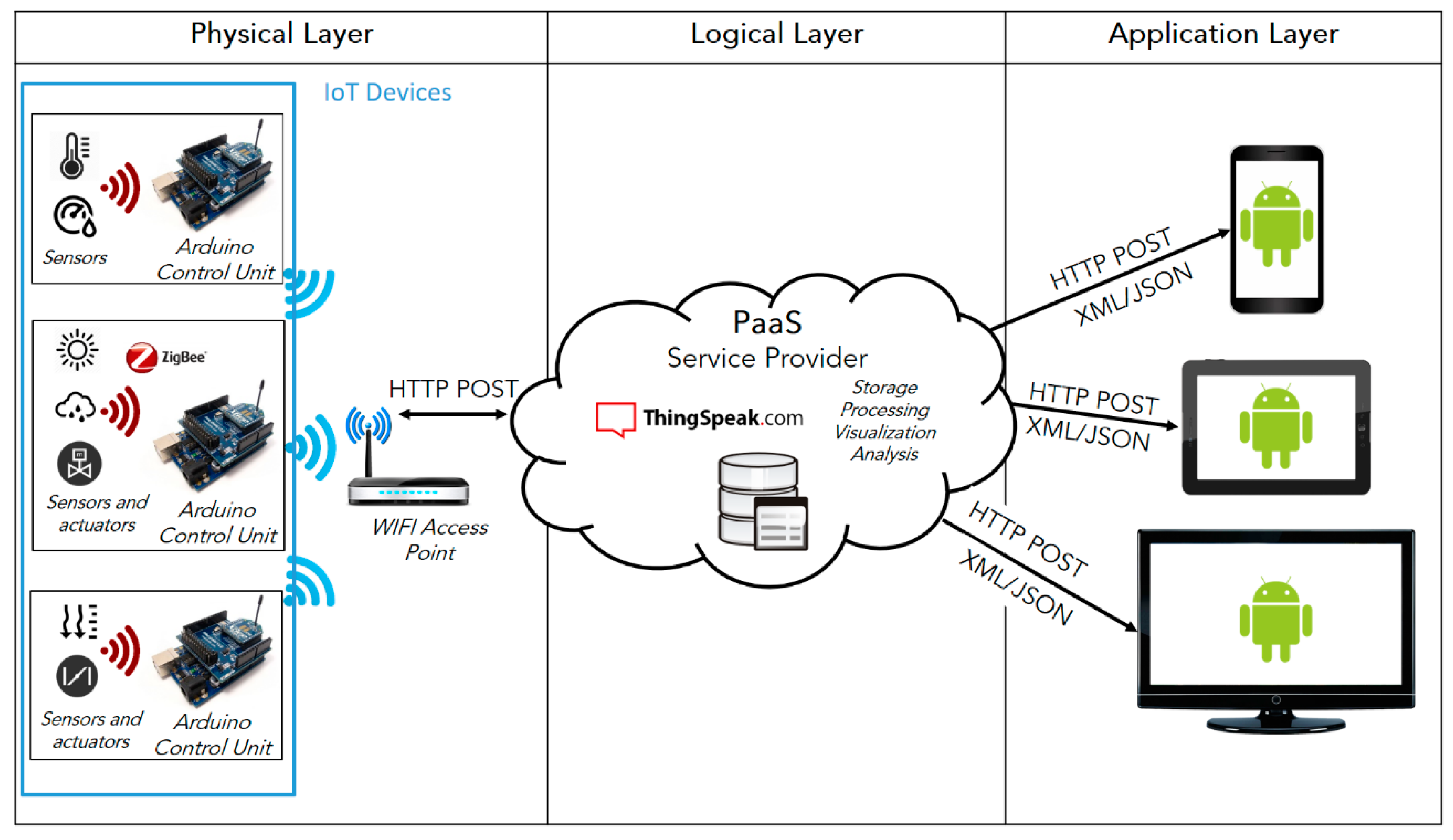
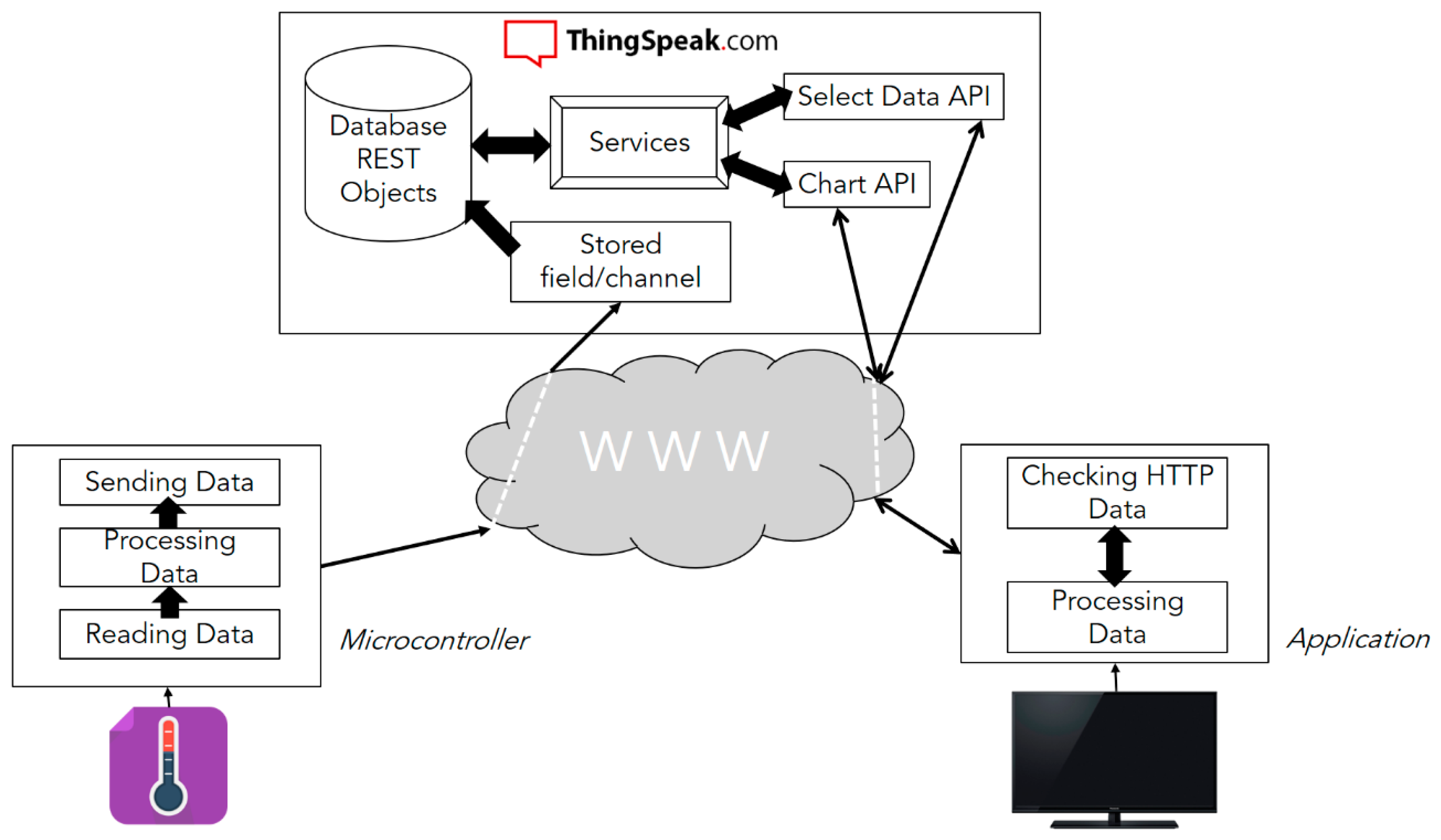
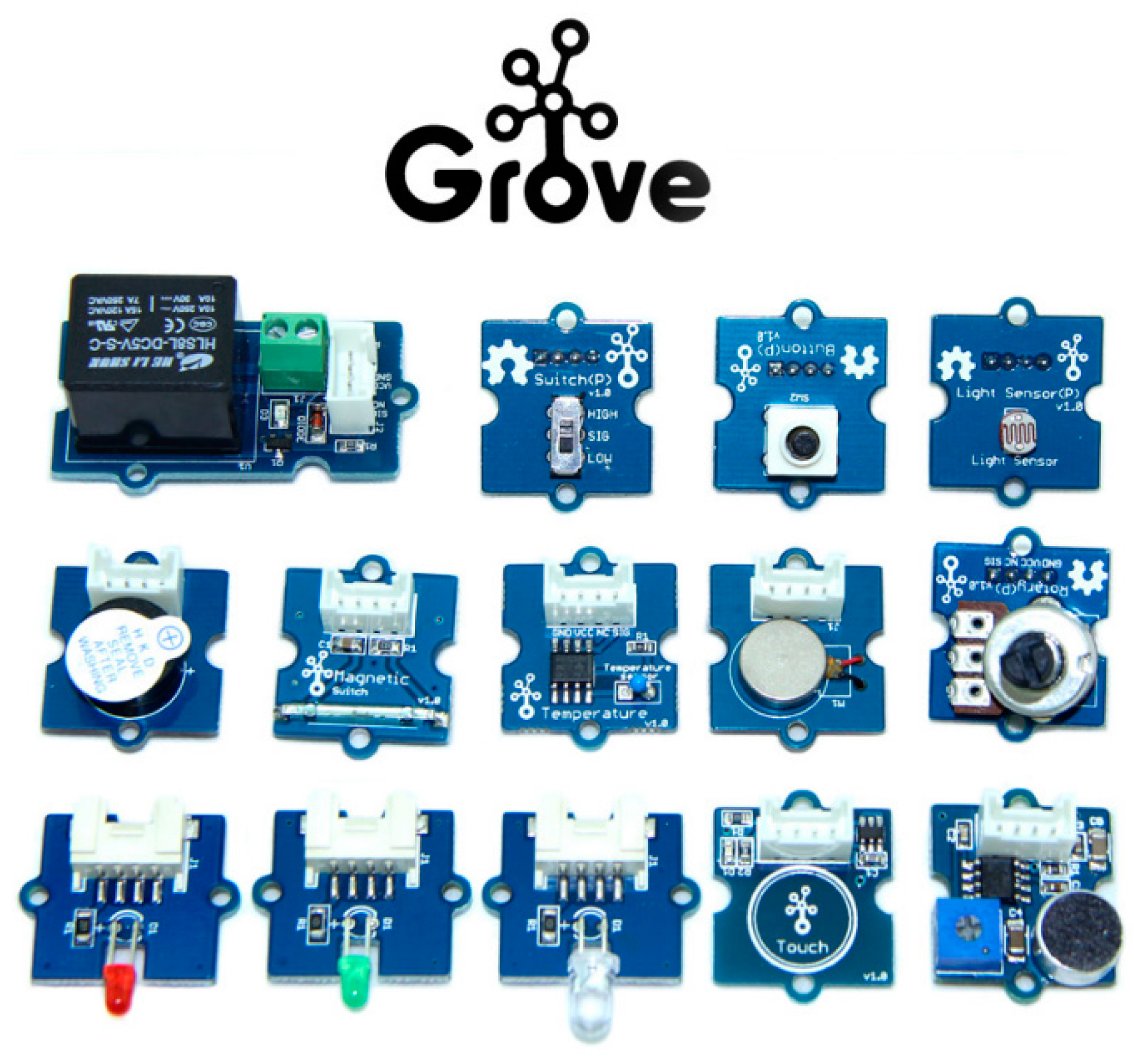

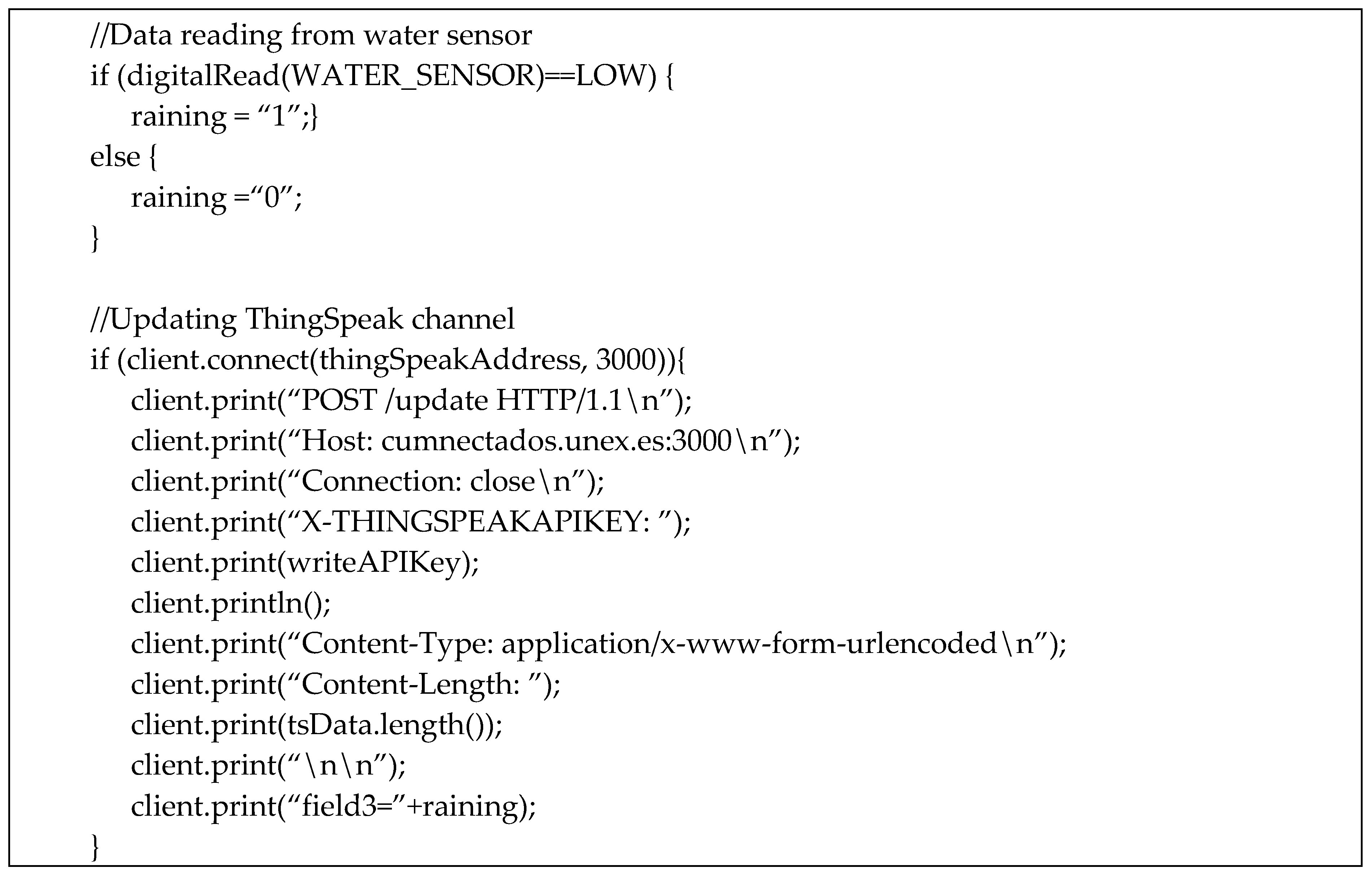
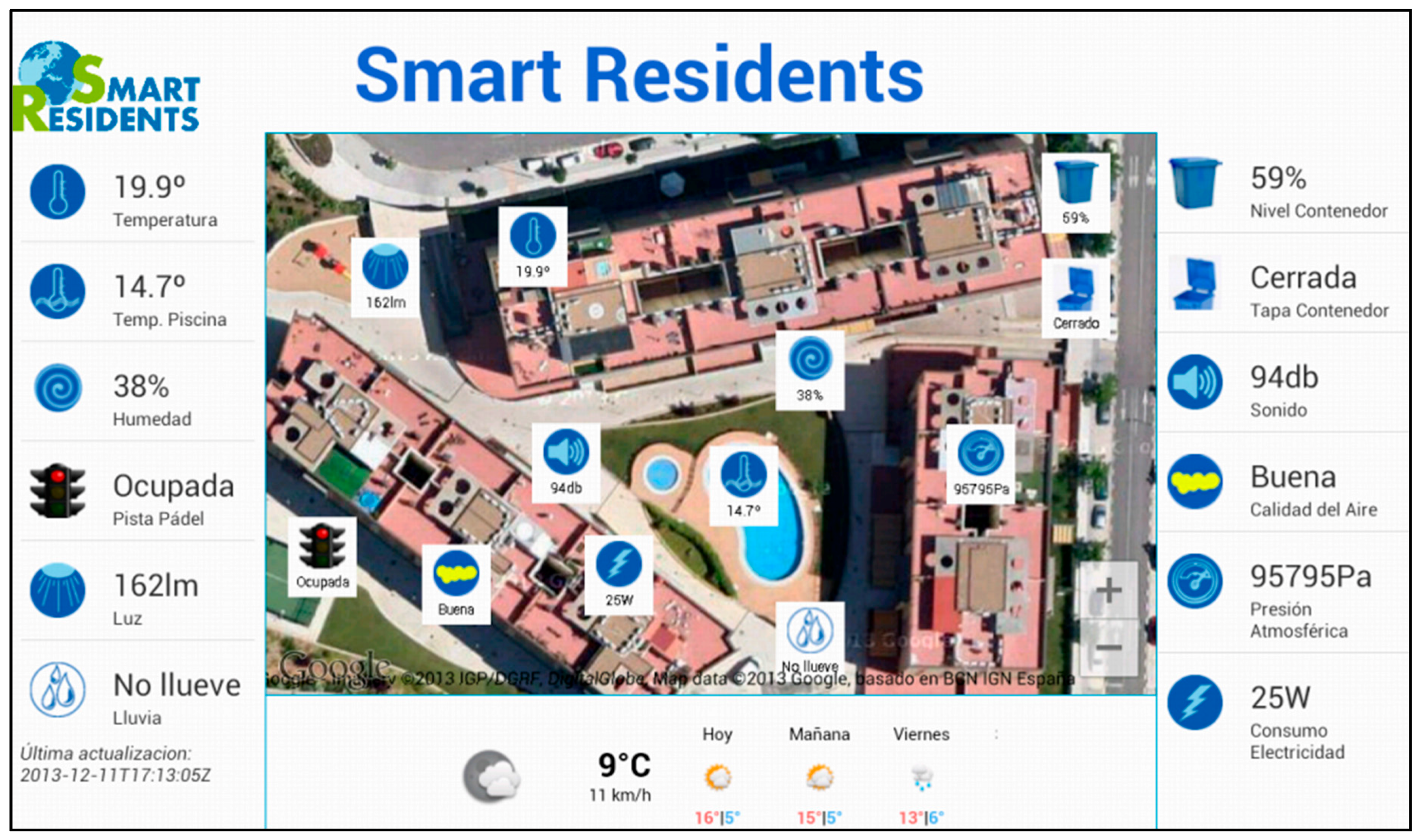
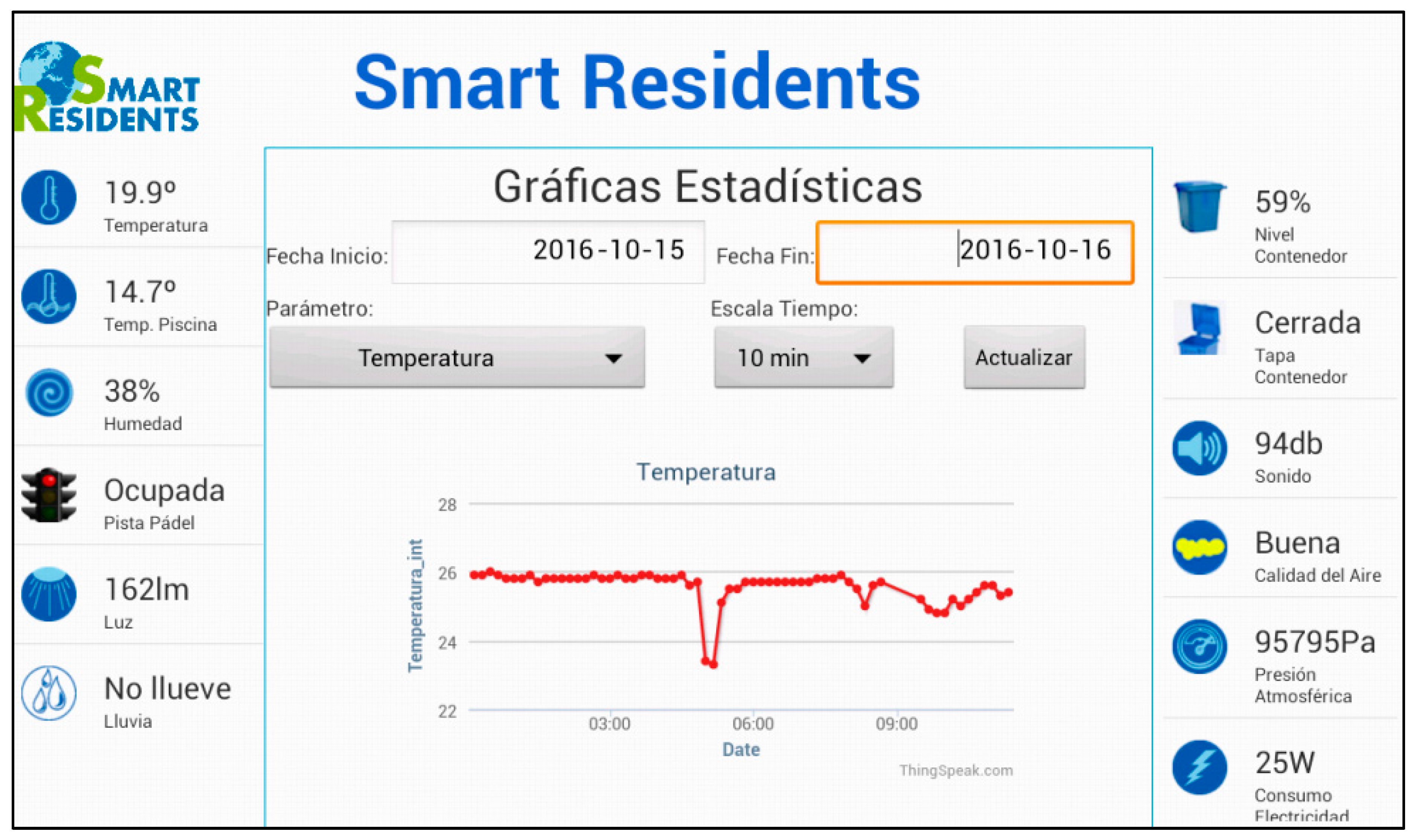

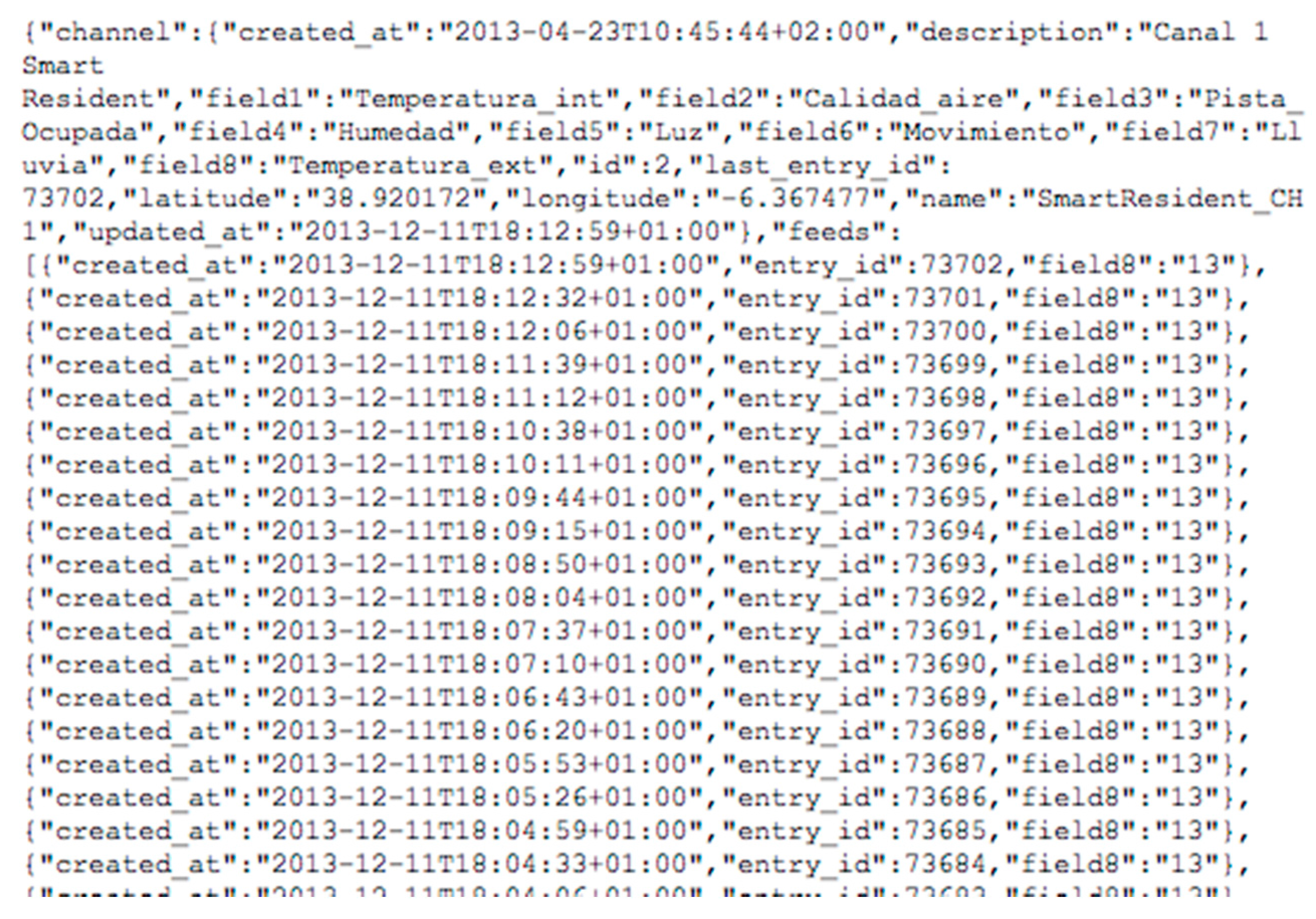
| Sensor | Magnitude | Type |
|---|---|---|
| Ambient temperature | °C | Analogue |
| Water temperature | °C | Analogue |
| Rain | Yes/No | Digital |
| Humidity | % | Analogue |
| Light | Lm | Analogue |
| Ultrasound | Cm | Analogue |
| Movement | Yes/No | Digital |
| Sound | Db | Analogue |
| Atmospheric pressure | Pa | Analogue |
| Electricity usage | W | Analogue |
| Air quality | level | Analogue |
| Smoke | level | Analogue |
| Channel | Field | Sensor |
|---|---|---|
| SmartResident_CH1 | ||
| Field1 | Temperature | |
| Field2 | Air quality | |
| Field3 | Rain | |
| Field4 | Humidity | |
| Field5 | Movement | |
| Field6 | Water temperature | |
| SmartResident_CH2 | ||
| Field1 | Rubbish container level | |
| Field2 | Rubbish container cap | |
| Field3 | Electricity usage | |
| Field4 | Sound | |
| Field5 | Smoke | |
| Field6 | Atmospheric pressure | |
© 2017 by the authors. Licensee MDPI, Basel, Switzerland. This article is an open access article distributed under the terms and conditions of the Creative Commons Attribution (CC BY) license (http://creativecommons.org/licenses/by/4.0/).
Share and Cite
Sánchez, H.; González-Contreras, C.; Agudo, J.E.; Macías, M. IoT and iTV for Interconnection, Monitoring, and Automation of Common Areas of Residents. Appl. Sci. 2017, 7, 696. https://doi.org/10.3390/app7070696
Sánchez H, González-Contreras C, Agudo JE, Macías M. IoT and iTV for Interconnection, Monitoring, and Automation of Common Areas of Residents. Applied Sciences. 2017; 7(7):696. https://doi.org/10.3390/app7070696
Chicago/Turabian StyleSánchez, Héctor, Carlos González-Contreras, J. Enrique Agudo, and Miguel Macías. 2017. "IoT and iTV for Interconnection, Monitoring, and Automation of Common Areas of Residents" Applied Sciences 7, no. 7: 696. https://doi.org/10.3390/app7070696




